


Le Pont Bailey M2 (Belgique Jambes)
English Transaltion
Les coupures humides ont de tout temps gêné la circulation des marchandises ou des armies
Dés l antiquité les hommes ont construit des ouvrages pour les traverser. Les ouvrages qui sont parvenus jusqu’à nous sont la plupart du temps des ouvrages civils en dur comme les ponts antiques de Rome D’autres ouvrages plus importants ne nous sont connus que par des textes des bas reliefs ou des pièces de Monnaies
Et quand il n y a pas de pont fixe on peut utiliser un pont de bateaux supportant un plancher . Ces ponts là peuvent utilisés de façon temporaire ou régulière
Le pont que Caligula fit construire pour traverser la baie de Naples à cheval en 37 Ap JC fait parti de la 1° définition alors que le Pont d’Arles en France qui permettait grâce à une construction mixte alliant les bateaux et la maçonnerie de franchir le Rhône fait partie de la 2° définition
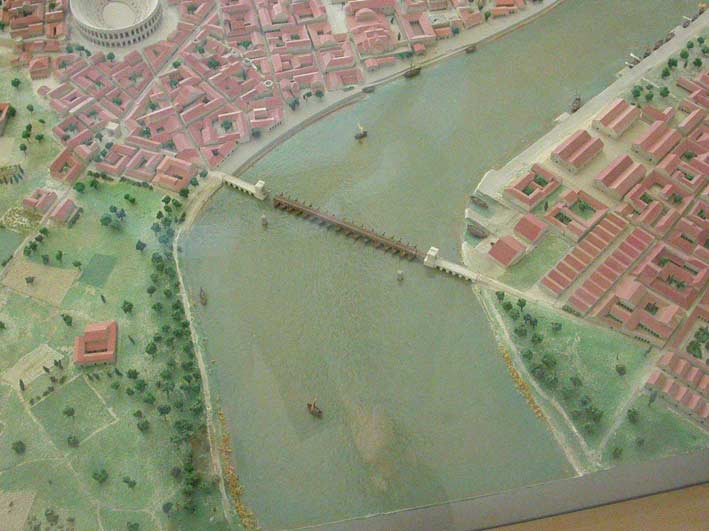 |
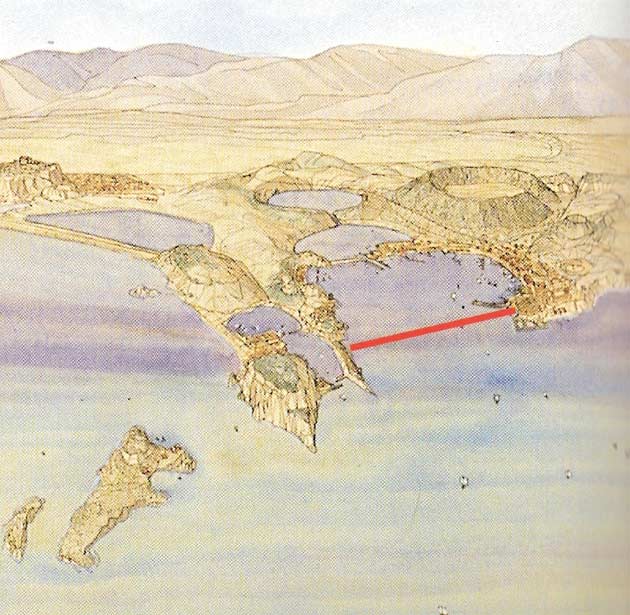 |
| Arles ( France Pont sur le Rhone) | Baie de Naples Pont de Caligula |
Pour les ouvrages militaires antiques rares sont les ponts survivants car ils ne furent construits que pour un temps donné
 |
|
| Roumanie Drobeta Pont d Appolodore de Damas | Istanbul emplacement Pont de Darius |
Il faut citer le pont de bateaux de 2 kilomètres construits par Darius lors de 1° Guerre Médique pour franchir le Bosphore sur l emplacement du Pont moderne de Sultan Mehmet
Par contre il reste des traces du Pont que fit construire Apollodore de Damas sur le Danube
Nous franchissons allégrement 1200 ans pour nous retrouver sur le même Danube avec Napoléon lors des batailles d’Essling et de Wagram et quelques années plus tard sur la Bérézina
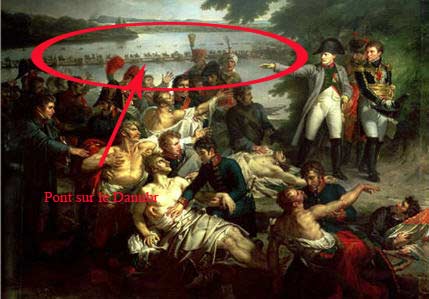 |
.jpg) |
| Soir Bataialle d'Essling Mai 1809 | La Bérésina (1812) |
Et pour terminer la Guerre de Sécession qui voit apparaître les Cumberland Pontoons qui furent utilisés par les Nordistes
La Première Guerre Mondiale voit quelques franchissements mais c’est surtout avec la 2° Guerre Mondiale que nous voyons apparaître un type de pont qui est encore utilisé de nos jour le Pont Bailey
en effet durant la première année de guerre de génie britannique dû faire face a un problème inadaptations des ponts pour faire passer certains les équipements blindés en effet le pont le plus lourd utilisé par les britanniques était une classe 19 t alors que le char Mathilda mis en service en 1939 pesait 23 t la première réaction fut de modifier le matériel existant ainsi le pont de classe 19 fut le porté à 24 t mais l'apparition de nouveaux matériels comme le Churchill qui était un char de la classe 40 t à obliger les britanniques à revoir leur copie ainsi naquit le pont Bailey
Qui est Bailey ?
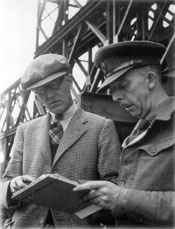 |
| Donald Bailey (à gauche) |
Sir Donald Coleman Bailey (1901 1985 ) etait un ingénieur Britannique Bailey
En tant qu’ingénieur Civil il travailla pour l ‘Etat Passionné de modélisme ferroviaire et après avoir étudié le Pont Routier français du début du siècle il présente son schéma au War Office qui adopte rapidement son idée
mais ici se place un problème de plagiat
En effet dans le même temps un autre ingénieur d’origine de Nouvelle Zélande Archibald Milne Hamilton (1898 - 1972) avait mis au point son système connu sous le nom de Callender-Hamilton bridge
Qui des deux a copié l autre Hamilton ou Bailey ? La question est délicate mais il s’est avéré que le système Bailey était supérieur sur beaucoup de points de vue du système Hamilton
Les deux inventeurs furent anoblis toutefois après la guerre
Voyons rapidement ce qui la différence entre les deux système en commençant par
le système Callender Hamilton
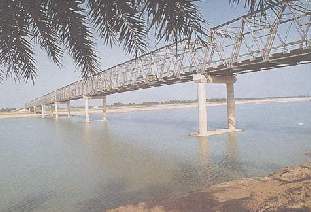 |
| Pont système Callender Hamilton |
La différence entre les deux systèmes vient de leur utilisation
les Callender-Hamilton Bridges sont des pont préfabriqués en structure métallique mais surtout pour une utilisation permanente. Les ponts ont une portée pouvant aller de 30 mètres à 150 mètres avec un nombre de voie pouvant aller jusqu’à3 voies voire même Les pièces sont traitées contre la corrosion . Toutes les pièces sont trempées galvanisé à chaud être assemblé sur une rive et ensuite poussé jusqu’à l’autre rive . Ces pont sont aux normes américaines et Européennes
Ils sont en général plus lourds que les ponts Bailey
Le Pont Bailey
Pour résumer Le Pont Bailey est un pont préfabriqué installé sur un site utilisant des éléments standart et pouvant être réutilisé sur un autre site Ce pont porte le nom de son concepteur.Mais revenons à l'historique le projet de Bailey fut étudié par une équipe composée du Major Jarrett Kerr du Royal Engineers de Ralph Freeman le concepteur du pont de Sydney et de Bailey . Partant d'un projet nouveau cette équipe décide de corriger tous les défauts des anciens projets ,notamment l'utilisation de matériaux stratégiques délicats en temps de guerre, simplification à l'extrême de la construction du pont . En effet dans le passé des projets étaient trop complexes et seulement très peu de personnes savaient monter les ponts du Génie militaire .Troisièmement l'usinage des différents éléments du port ne pouvait accepter de grande tolérance
Enfin l'équipe décida que ce pont devait être transporté par des camions de 3 t afin de simplifier la mise en place et la maintenance en éliminant autant que faire ce peut l'utilisation de grues
Le but
Construire un pont en éléments préfabriqués pouvant être transporté à six hommes.
Tel est la philosophie qui a été la ligne de conduite de l'équipe
En décembre 1941 les britanniques avaient solutionné tous les problèmes de ce pont pour les futures générations de blindés qui devaient apparaître et en parallèle les Américains commençaient à s'intéresser à ces moyen de franchissement
Ils se penchèrent sur le pont Bailey en mai 1940 après que l’US Army Ordnance Département annonça que le char moyenne de 15 t était obsolète et que des études pour des chars de 25 t et de 50 à 60 t furent lancées
Ils se heurtèrent aux mêmes problèmes que les britanniques avec leur système de pont de campagne et ils modifièrent les ponts existants ainsi le H10 devint le H 20
L’arrivée de bateaux pneumatiques résolus pour un temps certains problèmes de poids et de transport car ces bateaux étaient légers et d'une manipulation facile mais ils ne convenaient pour des ponts fixes.
Au début 1941 le génie américain lança des études pour des ponts lourds classe 30 et 50
En août 1941 les Américains et étudient la possibilité de modifier le pont Bailey pour le mettre au standard américain .Ainsi naquit le project SP 341 ou Portables Steel Bridge for Heavy Load. Il devait obéir à différents principes
La simplicité de mise en oeuvre et d’utilisation et la légèreté pour être transportable au moyen de véhicules militaires standards. Les s ingénieurs de la firme Sverdrup and Parcels de St Louis dans le Missouri mettent au point le système dont la construction fut donnée la firme Commercial Shearing and Stamping Company de Youngstown dans l’Ohio
La différence de conception de philosophie entre les Américains et les britanniques est flagrante :Là où les britanniques pour la construction d'un pont Bailey avaient besoin de 600 entreprises les Américains ont concentré la construction sur peu d’entreprises
Ceco Steel products Company de Chicago , International Steel compagnie de Evansville en Virginie et Bridge Company de Roanoke plus quelques entreprise de sous traitance
A la fin 1942 le premier pont était prêt pour les tests qui eurent lieu à Fort Beauvoir le 5 décembre 1942
La commission qui se réunit conseille l'adoption de ce pont pour les armées alliées ,et des manoeuvres grandeur nature eurent lieu dans le Tennessee en 1943 avec le 551e Ingeneers Heavy poontons Battalions qui construit rapidement un pont au-dessus d'une rivière ,Pont qui fut traversé par les divisions blindées
Mais se pose toujours le problème de l’interopérabilité du pont entre les Britanniques et les Américains car le système métrique anglais et américain était différent
Ce n'est qu'en août 1944 que les ingénieurs ont réussi à faire combiner les deux systèmes car jusqu'à présent 75 % des les éléments des deux systèmes n'étaient pas interchangeables à cause d'un problème de tolérance de certaines pièces
Malgré cela il ne faut pas oublier que le ce pont militaire a été le pont le plus le utilisé dans l'histoire militaire de la 2° Guerre Mondiale
Il a utilisé été utilisé par la 5° US Army et la VIII° armée britannique en Italie pour la première fois
Au total 3000 ponts Bailey furent construits et lancés sur des rivières suite à la destruction des ponts antérieurs par les forces de l'Axe en retraite Par exemple un pont sur le Volturno a permis le passage de 240 000 véhicules en huit mois
En Europe du Nord après le débarquement ses ponts furent largement utilisés . Le premier pont Bailey fut posé sur le sol français le 7 juin 1944 et la 3°US Army construisit 53 ponts de ce type et 11 ponts flottants
Ce pont fut aussi largement utilisé en Extrême Orient sur le théâtre d'opération à CBI (China Burma India , et avec la Jeep le Dakota et le Sherman le pont Bailey fait partie de la mythologie de la deuxième guerre mondiale
Il est encore largement utilisé de nos jours lors de catastrophes naturelles pour remplacer les ponts emportés par les éléments en furie ou détruits par les hommes lors de conflits partout dans le monde
Ainsi récemment le Génie Français à utilisé des ponts Bailey au Liban pour remplacer les ponts qui avaient été détruits par les forces israéliennes en juillet 2007
 |
| Logo Actuel Bailey |
The wet cuts have always hampered the business or the armies movements
From the Antiquity men have built bridge for crossing Some bridges have cross the siecles and they present now
They are mostly civil bridges as bridges of ancient Rome Other bridges most important are only known by texts or bas-relief or coins
And when there is no permanent bridge oyou can cross upon a boats bridge of boats bearing floor. These bridges are used there on a temporary or regular manner
The bridge that Caligula built to cross the Naples Bay on horseback in 37 AD JC is part of the 1st definition while the Arles Bridge in France which allowed through a construction combining boats and masonry to cross the Rhone is part of the 2nd definition
 |
 |
| Arles france Bridge Upon the Rhone | Naples Bridge of Caligula |
For the Antiquity military bridges survivors are rares because they were built for just a military campaing
 |
|
| Roumania Drobeta Appolodorus of Damascus Bridge | Turket Istanbul Position of Darius Bridge |
It included the 2 kilometres bridge of boats built by Darius during the 1st Medic War to cross the Bosphorus on the location du modern Bridge Sultan Mehmet
In other hans there are still traces of the bridge built Apollodorus of Damascus upon the Danube
We blithely cross 1200 years to find ourselves on the same Danube with Napoleon in battle of Essling and Wagram and a few years later on the Berezina
 |
.jpg) |
| Battle of Essling Mai 1809 | Berezina (1812) |
And finally the American Civil War(ACW) who are seeing Cumberland Pontoons which were used by northerners
WW1 saw a few crossings, but it is primarily with WW2 that we are seeing a kind of bridge that is still used our day the Bailey Bridge
Indeed, during the first years of war British engineering faced a problem with the maladjustments of they bridges and they new tanks
In fact they have only bridge class 19 t, while Mathilda char set service in 1939 weighed 23 t the first reaction was to modify the existing equipment and the bridge of class 19 was increased to 24 tonnes but the emergence of new materials like Churchill who was a tank of Class 40 t to compel the British to review their copy was born and the Bailey bridge
Who is Bailey?
 |
| Donald Bailey (ont the left) |
Sir Donald Coleman Bailey (1901 1985) was a British engineer. Bailey as an Civil engineer work for the War department . He was a passionate of hobby rail and after studying the french Bridge Road from the beginning of the century he introduced the scheme at the War Office, which quickly adopted his idea
but here is a problem of plagiarism
Indeed at the same time another engineer born ind New Zealand Archibald Milne Hamilton (1898 - 1972) had developed its system known as Callender-Hamilton bridge
Who has two copied the other Hamilton or Bailey?
The issue is delicate but it turned out that the system Bailey was higher on many points of view of the system Hamilton
The two inventors were ennoble however, after the war
Let's see quickly what the difference between the two system starting with
the system Callender Hamilton
|
|
| system Callender Hamilton |
The difference between the two systems comes from their use
the Callender-Hamilton Bridges are prefabricated bridge in steel structure, but especially for a permanent use. The bridges have a scope ranging from 30 metres to 150 metres with a number of lanes that can go since at 3 even Parts are treated against corrosion. All the pieces are dipped in hot galvanized be assembled on shore and then pushed to the other side. These are bridge the American and European standards
They are usually heavier than Bailey bridges
The Bailey bridge
To summarize The Bailey bridge is a prefabricated bridge installed on a site that uses standard components and can be reused on another site This bridge is named after its designer.
But back to the historic draft Bailey was examined by a team composed of Major Jarrett Kerr of the Royal Engineers Ralph Freeman designer of the bridge of the Sydney Bay and Bailey. Based on a new project ,team decided to correct all the faults of old projects, including the use of strategic materials delicate time of war, extreme simplification of the construction of the bridge. Indeed in the past projects were too complex and only very few people knew up bridges of Military Engineers. Thirdly machining of the various elements of the bridge could not accept high tolerance
Finally the team decided that this bridge would be transported by trucks t 3 to simplify the establishment and maintenance by eliminating as much as possible the use of cranes
The purpose is to Build a bridge Each prefabricated elements can be transported by six men.
That is the philosophy which has been the guiding principle for the team
In December 1941 the British had solved all the problems of this bridge for future generations of armoured who were to appear and in parallel Americans began to pay attention to these means of crossing
The interest to this Bailey bridge become in May 1940 after the U.S. Army Ordnance Department announced that the 15 tons tank was obsolete and that studies for 25 and 50 or 60tons tanks were launched
They were met with the same problems that the British with their system of bridge campaign Also the bridges H10 became the M 20
The arrival of inflatable boats resolved for a time some weight problems and transport as these boats were light and easy handling but not suitable for fixed bridges.
In early 1941 the U.S. engineering began studies for heavy bridges class 30 and 50
In August 1941 the Americans studying the possibility of modifying the Bailey bridge to bring to the American standard. Thus was born the project SP 341 or Mobile Steel Bridge for Heavy Load. He had to obey different principles
The simplicity of implementation and use, and lightness to be transportable by military vehicles standards. The engineers from the firm Sverdrup and Parcels of St Louis in Missouri are developing the system whose construction was given the firm Commercial Shearing and Stamping Company of Youngstown in Ohio
The difference in philosophy design between the Americans and British is evident: Where for the British the construction of a Bailey bridge need 600 companies the Americans have concentrated on the construction on a few companies
Ceco products Steel Company of Chicago, International Steel company in Evansville VA and Bridge Company in Roanoke, and little more for business outsourcing
At the end of 1942 the first bridge was ready for tests that took place at Fort Beauvoir on December 5th 1942
The Committee which meets advises the adoption of this bridge for the allied armies, and bigs manoeuvres took place in Tennessee in 1943 with the 551st Ingeneers Heavy poontons Battalions which quickly built a bridge over a river bridge which was crossed by armored divisions
But always arises the problem of interoperability of this bridge between British and Americans because the metric system between American and English was different
It was not until August 1944 that engineers have managed to combine the two systems because so far 75% of the elements of both systems were not interchangeable further to a problem tolerance of some parts
But whe do not forget that this military bridge was the bridge the most used in the military history of WW 2
He used been used by 5 ° U.S. Army and VIII ° British army in Italy for first time
A total of 3000 Bailey bridges were built and launched on rivers following the destruction of bridges earlier by the Axis forces retreating For example, a bridge over the Volturno allowed the passage of 240 000 vehicles in eight months
In Northern Europe after landing its bridges were widely used. The first Bailey bridge was placed on the french ground on June 7th 1944 and the 3rd U.S. Army built 53 bridges of this type and 11 floating bridges
This bridge was also widely used in the Far East in CBI theatre (China Burma India ), and with the Jeep ,Dakota, Sherman the Bailey bridge is part of the mythology of WW2
It is still widely used today during natural disasters to replace bridges washed away by the raging elements or destroyed by men in conflicts throughout the world
As recently by French engineering used Bailey bridges in Lebanon to replace bridges that were destroyed by Israeli forces in July 2007
The Bailey system
This system is different from the previous several points; It is designed as a big MECANO game. It is built for temporary use and can be reused. It also lighter but what has been its success is its modular design, and the fact that it can be assembled with little heavy equipment. The modular design enabled engineers to build each cut its wet deck
. Each element is interchangeable and can be transported by a small number of men, which allows repair quickly to better manage the flow of men and material that presents itself
It is characterized by sections of steel-timbered easy to spot
Bridge Component
Roadway crossbar and stringers
It consists of a number of crossbar of 5.8 m long and stringers of 3 m length which once assembled form a square
The rigidity of the bridge is provided by square modules which are placed on each side The wooden floor is at the root replaces during the war by plate steel more resistant
The bridge is built by section 3 m length 4 meters wide and 1.52 high
Each section can be carried by 6 men. The assembled sections are bolted together forming a bridge that can be put in place by a system of rollers using cranes or bulldozers giving a bridge with a span of 10 m to 60 metres for a charge of 10 to 100 tons
The bridge can also be based on elements of Bailey bridges forming a pillar with 3 elements Bailey for a a span of 60 m.
There are 2 versions
Version M2 (BBM2) and expanded version EWBB (Extra Wide Bailey Bridge)
It may also be spears on portieres or rafts (J52)
Depending on the configuration and employment on the ground may be built Singles (one row of panels on deck) or double simple (6 spans)
The implementation Two hours is sufficient to 40 engineers to install a basic structure of 20 meters length.
We must first take of field measurements (width of the cut topographic map delimitation site
Then we must establish the bridge project (number of elements means in men and material handling)
Materialisation of placement axis and support elements
Adjustments of the Bridge aproaches construction of a kind o drawbridge built in front of the bridge to enable it to reach the opposite bank
Construction of the bridge itself The bridge is put in place gradually over the gap with the help of gears
At the end dismantling the drawbridge before laying on the bridge over the final support, the pavement ramps and possibly signalling and a bridge for pedestrians
Thanks to Jean Marie for this pics
MODEL EXISTING IN 1/35° YES BRONCO MODELS
 |
| Actual Logo |